-
 Bitcoin
Bitcoin $106,754.6083
1.33% -
 Ethereum
Ethereum $2,625.8249
3.80% -
 Tether USDt
Tether USDt $1.0001
-0.03% -
 XRP
XRP $2.1891
1.67% -
 BNB
BNB $654.5220
0.66% -
 Solana
Solana $156.9428
7.28% -
 USDC
USDC $0.9998
0.00% -
 Dogecoin
Dogecoin $0.1780
1.14% -
 TRON
TRON $0.2706
-0.16% -
 Cardano
Cardano $0.6470
2.77% -
 Hyperliquid
Hyperliquid $44.6467
10.24% -
 Sui
Sui $3.1128
3.86% -
 Bitcoin Cash
Bitcoin Cash $455.7646
3.00% -
 Chainlink
Chainlink $13.6858
4.08% -
 UNUS SED LEO
UNUS SED LEO $9.2682
0.21% -
 Avalanche
Avalanche $19.7433
3.79% -
 Stellar
Stellar $0.2616
1.64% -
 Toncoin
Toncoin $3.0222
2.19% -
 Shiba Inu
Shiba Inu $0.0...01220
1.49% -
 Hedera
Hedera $0.1580
2.75% -
 Litecoin
Litecoin $87.4964
2.29% -
 Polkadot
Polkadot $3.8958
3.05% -
 Ethena USDe
Ethena USDe $1.0000
-0.04% -
 Monero
Monero $317.2263
0.26% -
 Bitget Token
Bitget Token $4.5985
1.68% -
 Dai
Dai $0.9999
0.00% -
 Pepe
Pepe $0.0...01140
2.44% -
 Uniswap
Uniswap $7.6065
5.29% -
 Pi
Pi $0.6042
-2.00% -
 Aave
Aave $289.6343
6.02%
How to deal with the long arrangement of moving averages but not accelerating the rise?
A long arrangement of moving averages typically signals a strong trend, but stalled price action may indicate consolidation, weak buying pressure, or macro influences.
Jun 17, 2025 at 04:35 am
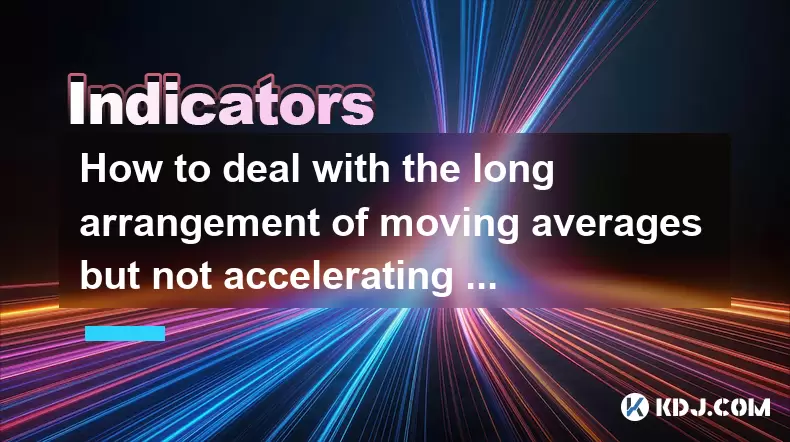
Understanding the Long Arrangement of Moving Averages
When traders talk about a long arrangement of moving averages, they usually refer to a situation where multiple moving averages (such as the 20-day, 50-day, and 200-day) are aligned in a consistent upward or downward pattern. In this case, we focus on an upward alignment that does not result in a rapid price increase. This scenario can be confusing because the technical indicators suggest strength, yet the actual price action remains subdued.
A long arrangement typically signals a strong trend, but when prices do not accelerate despite this setup, it often indicates underlying weakness or consolidation within the market structure. Understanding this divergence is crucial for making informed trading decisions in cryptocurrency markets.
Why Price Doesn't Accelerate Despite Moving Average Alignment
There are several possible reasons why price may not surge even though moving averages are arranged in a bullish formation:
- Market Saturation: In mature crypto assets like Bitcoin or Ethereum, large institutional participation can flatten volatility, leading to slow and steady moves rather than explosive ones.
- Profit-Taking Zones: When key resistance levels have been reached previously, traders may take profits at similar levels, preventing breakout momentum.
- Volume Deficiency: Without increasing volume, especially in altcoins, buyers lack conviction, which stalls upward movement.
- Macro Factors: Broader economic conditions, such as interest rate changes or regulatory news, can suppress price movement regardless of technical setups.
These factors illustrate how fundamental and behavioral dynamics can override purely technical signals.
Identifying Consolidation Patterns Within the Trend
Before assuming something is wrong with the trend, it's essential to identify whether the market is entering a consolidation phase. These phases are normal in trending environments and allow for reaccumulation or distribution before the next leg begins.
Common signs of consolidation include:
- Price moving sideways within a tight range
- Reduced volatility and smaller candle bodies
- Moving averages flattening slightly or converging temporarily
Traders should monitor support levels formed by recent swing lows and observe if price holds above them. If so, the long-term trend remains intact, and patience may yield better entry points later.
Adjusting Trading Strategy During Stagnant Price Action
When faced with a long moving average setup without acceleration, traders need to adapt their strategy instead of forcing trades. Here’s what you can do:
- Avoid Overleveraging: Since price isn’t accelerating, aggressive entries could lead to stop-outs or margin calls.
- Monitor Volume Indicators: Use tools like On-Balance Volume (OBV) or Chaikin Money Flow to gauge buying pressure.
- Watch for Breakouts: Set alerts near key resistance levels or Fibonacci extensions where a potential move might begin.
- Use Range Bound Strategies: Consider selling call options or shorting during overbought readings if volatility allows.
This approach ensures that you remain engaged without exposing yourself to unnecessary risk during uncertain phases.
Using Other Technical Tools to Confirm or Reject the Setup
Relying solely on moving averages can be misleading. It's wise to incorporate other indicators to validate or question the current structure:
- Relative Strength Index (RSI): Check if RSI is in neutral territory (40–60), indicating neither overbought nor oversold conditions.
- MACD Histogram: Look for contraction in the histogram bars, signaling weakening momentum.
- Fibonacci Retracement Levels: Identify potential support zones based on prior swings to assess if the pullback is healthy or concerning.
By combining these tools, traders gain a more holistic view of whether the market is simply pausing or reversing.
Managing Expectations and Emotional Discipline
One of the most overlooked aspects of dealing with stalled trends is emotional management. Seeing a textbook bullish setup fail to deliver immediate results can frustrate traders and lead to impulsive decisions.
To maintain discipline:
- Stick to Your Trading Plan: Revisit your initial thesis and only deviate if new information invalidates it.
- Journal Your Observations: Record why you entered the trade and note any evolving patterns.
- Practice Patience: Understand that markets don’t always reward setups immediately; sometimes waiting is the best strategy.
This mindset helps prevent knee-jerk reactions and keeps your decision-making process grounded.
Frequently Asked Questions
Q: What time frame is best for analyzing a long arrangement of moving averages?
A: While daily charts are commonly used for identifying long arrangements, shorter time frames like 4-hour or 1-hour can help spot micro-trends and improve timing for entries or exits.
Q: Can I still trade during consolidation even if the moving averages are aligned?
A: Yes, traders can engage in range-bound strategies, scalping, or swing trading opportunities within the consolidation zone, provided proper risk controls are in place.
Q: Should I close my position if price doesn’t rise after a long MA setup?
A: Not necessarily. Evaluate volume, broader market sentiment, and macro conditions before deciding. Closing prematurely might cause you to miss future gains.
Q: Are moving averages reliable in volatile crypto markets?
A: Moving averages work best in trending markets but can produce false signals in choppy or sideways conditions. Combining them with volume analysis improves reliability.
Disclaimer:info@kdj.com
The information provided is not trading advice. kdj.com does not assume any responsibility for any investments made based on the information provided in this article. Cryptocurrencies are highly volatile and it is highly recommended that you invest with caution after thorough research!
If you believe that the content used on this website infringes your copyright, please contact us immediately (info@kdj.com) and we will delete it promptly.
- 2025-W Uncirculated American Gold Eagle and Dr. Vera Rubin Quarter Mark New Products
- 2025-06-13 06:25:13
- Ruvi AI (RVU) Leverages Blockchain and Artificial Intelligence to Disrupt Marketing, Entertainment, and Finance
- 2025-06-13 07:05:12
- H100 Group AB Raises 101 Million SEK (Approximately $10.6 Million) to Bolster Bitcoin Reserves
- 2025-06-13 06:25:13
- Galaxy Digital CEO Mike Novogratz Says Bitcoin Will Replace Gold and Go to $1,000,000
- 2025-06-13 06:45:13
- Trust Wallet Token (TWT) Price Drops 5.7% as RWA Integration Plans Ignite Excitement
- 2025-06-13 06:45:13
- Ethereum (ETH) Is in the Second Phase of a Three-Stage Market Cycle
- 2025-06-13 07:25:13
Related knowledge
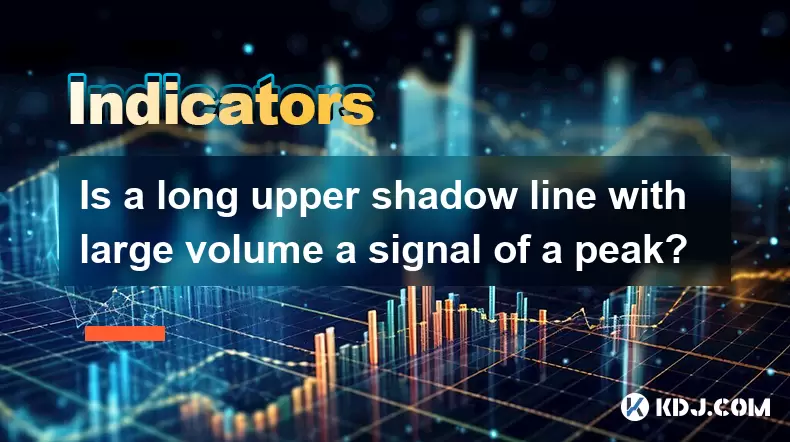
Is a long upper shadow line with large volume a signal of a peak?
Jun 17,2025 at 05:07am
Understanding the Long Upper Shadow LineA long upper shadow line, often referred to as a shooting star or inverted hammer depending on its location in a chart, is a candlestick pattern that indicates potential reversal from an uptrend. This pattern forms when prices rise significantly during the trading period but then fall back to close near the openin...

How to confirm the effectiveness of the average price line support in the time-sharing chart?
Jun 17,2025 at 12:56am
Understanding the Time-Sharing Chart and Its RelevanceIn cryptocurrency trading, time-sharing charts play a crucial role in analyzing short-term price movements. These charts typically display price fluctuations over a specific period, often ranging from minutes to hours. Traders rely on them to make quick decisions based on real-time data. The average ...
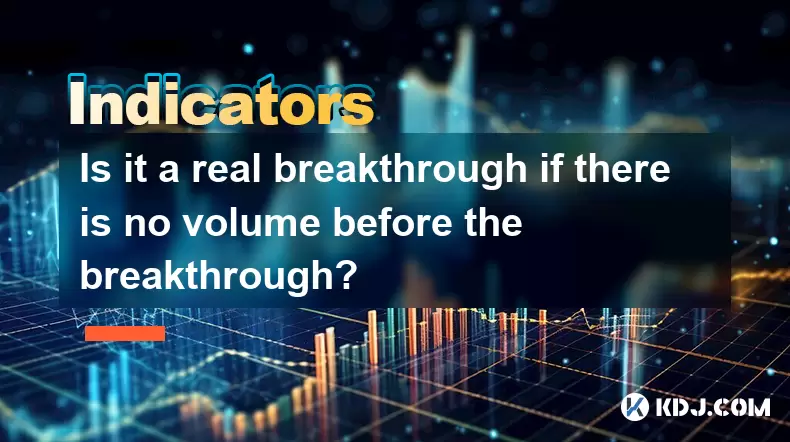
Is it a real breakthrough if there is no volume before the breakthrough?
Jun 17,2025 at 08:03am
Understanding the Concept of a Breakthrough in Cryptocurrency TradingIn cryptocurrency trading, a breakthrough typically refers to a price movement that surpasses a key resistance or support level. Traders often look for such events as potential signals for trend continuation or reversal. However, a crucial factor that determines the strength and reliab...

What does it mean when the momentum indicator breaks above the zero axis?
Jun 17,2025 at 12:43am
Understanding the Momentum IndicatorThe momentum indicator is a technical analysis tool used to measure the speed or velocity of price movements in cryptocurrency markets. It helps traders identify potential trend reversals, overbought or oversold conditions, and confirms existing trends. The indicator typically oscillates around a zero line, with value...
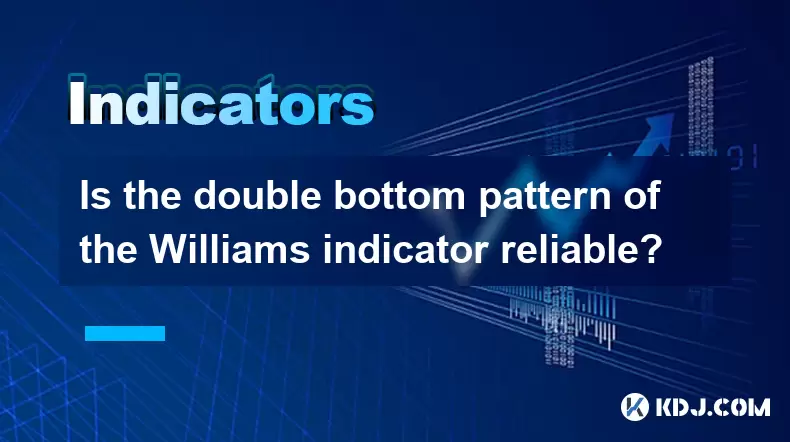
Is the double bottom pattern of the Williams indicator reliable?
Jun 17,2025 at 03:56am
Understanding the Williams Indicator and Its SignificanceThe Williams %R indicator, often referred to as Williams Percent Range, is a momentum oscillator used in technical analysis to identify overbought or oversold conditions in the market. Developed by Larry Williams, this indicator fluctuates between 0 and -100, with readings above -20 indicating ove...
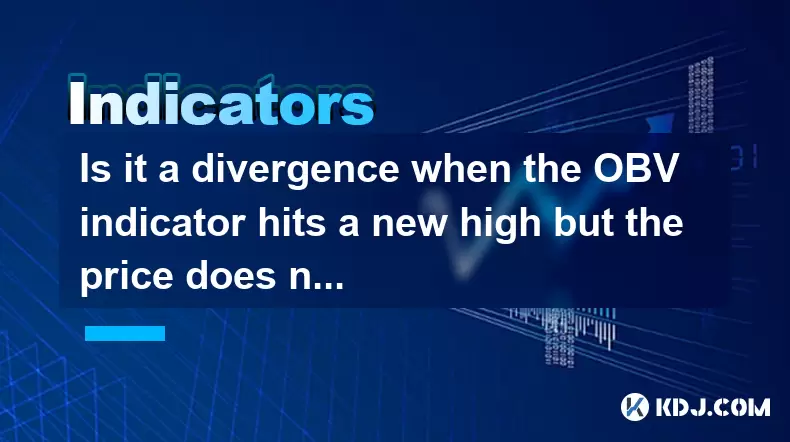
Is it a divergence when the OBV indicator hits a new high but the price does not rise?
Jun 17,2025 at 11:15am
Understanding the On-Balance Volume (OBV) IndicatorThe On-Balance Volume (OBV) is a momentum indicator used in technical analysis to predict changes in stock or cryptocurrency prices. It measures buying and selling pressure by adding volume on up days and subtracting volume on down days. The idea behind OBV is that volume often precedes price movement, ...

Is a long upper shadow line with large volume a signal of a peak?
Jun 17,2025 at 05:07am
Understanding the Long Upper Shadow LineA long upper shadow line, often referred to as a shooting star or inverted hammer depending on its location in a chart, is a candlestick pattern that indicates potential reversal from an uptrend. This pattern forms when prices rise significantly during the trading period but then fall back to close near the openin...

How to confirm the effectiveness of the average price line support in the time-sharing chart?
Jun 17,2025 at 12:56am
Understanding the Time-Sharing Chart and Its RelevanceIn cryptocurrency trading, time-sharing charts play a crucial role in analyzing short-term price movements. These charts typically display price fluctuations over a specific period, often ranging from minutes to hours. Traders rely on them to make quick decisions based on real-time data. The average ...

Is it a real breakthrough if there is no volume before the breakthrough?
Jun 17,2025 at 08:03am
Understanding the Concept of a Breakthrough in Cryptocurrency TradingIn cryptocurrency trading, a breakthrough typically refers to a price movement that surpasses a key resistance or support level. Traders often look for such events as potential signals for trend continuation or reversal. However, a crucial factor that determines the strength and reliab...

What does it mean when the momentum indicator breaks above the zero axis?
Jun 17,2025 at 12:43am
Understanding the Momentum IndicatorThe momentum indicator is a technical analysis tool used to measure the speed or velocity of price movements in cryptocurrency markets. It helps traders identify potential trend reversals, overbought or oversold conditions, and confirms existing trends. The indicator typically oscillates around a zero line, with value...

Is the double bottom pattern of the Williams indicator reliable?
Jun 17,2025 at 03:56am
Understanding the Williams Indicator and Its SignificanceThe Williams %R indicator, often referred to as Williams Percent Range, is a momentum oscillator used in technical analysis to identify overbought or oversold conditions in the market. Developed by Larry Williams, this indicator fluctuates between 0 and -100, with readings above -20 indicating ove...

Is it a divergence when the OBV indicator hits a new high but the price does not rise?
Jun 17,2025 at 11:15am
Understanding the On-Balance Volume (OBV) IndicatorThe On-Balance Volume (OBV) is a momentum indicator used in technical analysis to predict changes in stock or cryptocurrency prices. It measures buying and selling pressure by adding volume on up days and subtracting volume on down days. The idea behind OBV is that volume often precedes price movement, ...
See all articles

























































































